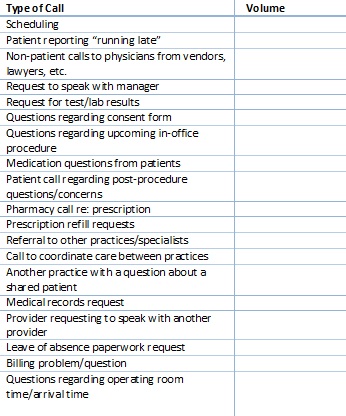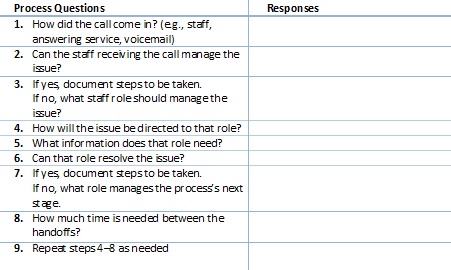Phone management is critical to a practice’s success. Telephone calls from patients and other practices are the cornerstone of most ambulatory practices.
All components of a best-in-class phone management model (e.g., scripting, menu options, staffing model, expectations for return calls) must be actively managed to attain high levels of efficiency and positive patient experiences.
- The MGH Telecom Department offers two features for managing inbound calls. You can choose to use one or both tools (or neither), but the phones must be actively managed.
- An automated call handler, also known as a phone tree or phone menu, routes calls based on the option that the caller selects.
- Automated Call Distributor (ACD), also known as UCCE, queues incoming calls for the next available agent.
- The abandonment rate should not exceed 5% of all calls; speed-to-answer rate should be 80% of calls within 30 seconds.
- Run reports to monitor performance and identify opportunities for change or best practices. If reporting methods are not available for your system, conduct “secret shopping” by calling the practice anonymously to understand what your patients are experiencing and measure adherence to department algorithms and standards.
Telecommunications Setup Checklist
- Document all phone lines managed by your practice and the types of calls received. See the Types of Call Worksheet below.
- Document your use of call handlers, ACD systems, and voicemails.
- If you use the ACD system, run a set of baseline reports.
- If you use a call handler, request data on the volume for each menu option.
Types of Call Worksheet
(click image to download worksheet PDF)
Determine if the volume and type of calls warrant extension of phone operating hours or a shift in staffing resources.
- Answer phones live from Monday to Friday, 8 am to 5 pm.
- Begin staffing phones at least 30 minutes prior to the first scheduled appointment.
- Staff phones at lunchtime.
- Use voicemail sparingly.
- Check voicemail at least once per hour.
- Provide group and individual voicemail coverage.
- For each type of call received, develop/use a script that includes the standard four-part greeting:
- Greeting
- Name of department/practice
- Name of person answering the call
- Offer to help
- Follow the standards for callbacks:
- Return calls received before 3 pm the same day.
- Return calls received after 3 pm by 10 am the next business day.
- Design and implement a formal quality assurance and coaching program that includes monitoring five calls per month for each staff person and that provides regular feedback.
- Use the First-Call Resolution Worksheet (see below) to identify how to address each call upon initial contact and develop a plan to implement first-call resolution.
- Update Cadence schedules regularly so staff can readily access the latest information and avoid rework or callbacks to patients.
- If a call cannot be immediately resolved, and the patient needs to be called back, send messages via In Basket to Pools; send messages to specific people in well-defined circumstances. Use Smart Phrases to collect key pieces of information.
First-Call Resolution Worksheet
(click image to download worksheet PDF)
- TeleVox is our automated appointment reminder system. Calling and texting is available for all practices. The expectation is that your practice be set up on the TeleVox system.
- Hospital leadership uses TeleVox to communicate to patients if the institution is affected by a major weather event or other occurrence.
- The TeleVox reminder system runs as follows:
- A secure and encrypted file of patient appointments from MGH is sent to TeleVox at 2:30 am for appointments three days out.
- TeleVox then sorts the data and calls or texts the patient based on age.
- Patients over the age of 70 are called between 10:00 am–1:00 pm.
- Patients under the age of 70 are called between 6:00 pm–8:30 pm.
- All text reminders are sent at 12:00 noon and patients have 26 hours to respond. After 26 hours, the message expires.
- Phone line issues or texts that could not be delivered are retried the next day beginning at 9:00 am.
- Statuses from patients are collected by TeleVox and sent back to MGH.
- TeleVox confirmation comes in and updates the DAR and TeleVox report.
- If the appointment was confirmed, the practice does not need to do anything.
- If the appointment was cancelled, or the message or text did not go through, the practice must reach out to the patient.
- If the appointment was cancelled via TeleVox, the practice must cancel the appointment on the schedule or call the patient to attempt to reschedule the appointment.
- The practice must actively work the Waitlist in Epic to fill open slots.
- The TeleVox reporting column is located on the PHS Standardized DARs.
- ACD Reports. Available in Partners Apps under “UCCE Reporting ̶ PHS” . If your department uses ACD and you do not see this in your Partners Apps, request access by submitting a Help Desk Ticket. When entering the ticket, put “MGH Telecom UCCE” as the application in the Use section.
- Call Handler Reports. Request call handler reports from MGH Telecom by submitting a Help Desk ticket. When entering the ticket, put “MGH Telecom UCCE” as the application in the Use section.
- Mass General Brigham Safeguarding Fax, Copiers, Printers, Telephone Use and Pagers Policy
TeleVox
Practice
Infectious Disease
Problem
The phone system for MGH Infectious Disease was too complicated for staff to manage and frustrating for patients to navigate. Without a phone system that works efficiently, patient and staff satisfaction will be impacted, the ability of the Infectious Disease team to answer patient calls promptly will be impacted, and timely access to care will be impacted. The Infectious Disease team contacted the Practice Improvement Division for assistance.
Actions Taken
- Provided standard reports (e.g., call volume, call abandonment)
- Categorized calls to understand the reason for each type of call
- Updated the telephone menu and prompts to efficiently connect patients to the right person and to quickly connect callers to live person (with a high priority on new patients calling for initial appointments)
Results
- Improved patient experience scores by more than 10 points for both “patient got routine care appointment” and “patient got answer during regular hours,” far exceeding the initial goal.
- Managers report that staff are happier, patients complain less about reaching live staff, and that the office “feels less busy/stressful.”
- Urgent (booked/“arrived same day or next day”) access increased more than 10%.


